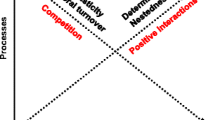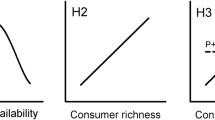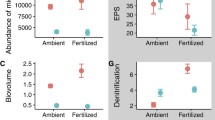Abstract
Short-term responses of producers highlight that key nutrients (e.g., N, P)—or combinations of these nutrients—limit primary production in aquatic and terrestrial ecosystems. These discoveries continue to provide highly valuable insights, but it remains important to ask whether nutrients always predominantly limit producers despite wide variation in nutrient supply and herbivory among systems. After all, predictions from simple food chain models (derived here) readily predict that limitation by grazers can exceed that by nutrients, given sufficient enrichment. However, shifts in composition of producers and/or increasing dominance of invulnerable stages of a producer can, in theory, reduce grazer limitation and retain primacy of nutrient limitation along nutrient supply gradients. We observed both mechanisms (inter- and intra-species variation in vulnerability to herbivory) working in a two-part mesocosm experiment. We incubated diverse benthic algal assemblages for several months either in the presence or absence of benthic macro-grazers in mesocosms that spread a broad range of nutrient supply. We then conducted short-term assays of nutrient and grazer limitation on these communities. In the “historically grazed” assemblages, we found shifts from more edible, better competitors to more resistant producers over enrichment gradients (as anticipated by the food web model built with a tradeoff in resistance vs. competitive abilities). However, contrary to our expectations, “historically ungrazed” assemblages became dominated by producers with vulnerable juvenile forms but inedible adult forms (long filaments). Consequently, we observed higher resource limitation rather than grazer limitation over this nutrient supply gradient in both “historically grazed” (expected) and “historically ungrazed” (not initially expected). Thus, via multiple, general mechanisms involving resistance to grazing (changes in species composition or variation in stage-structured vulnerability), producer assemblages should remain more strongly or as strongly limited by nutrients than grazers, even over large enrichment gradients.




Similar content being viewed by others
References
APHA (1980) Standard methods for the examination of water and wastewater, 15th edn. APHA
Anderson MJ (2001) A new method for non-parametric multivariate analysis of variance. Aust Ecol 26:32–46
Anderson MJ (2002) CAP: a FORTRAN computer program for canonical analysis of principal coordinates. Department of Statistics, University of Auckland, New Zealand
Anderson MJ (2005) PERMANOVA: a FORTRAN computer program for permutational multivariate analysis of variance. Department of Statistics, University of Auckland, New Zealand
Anderson MJ, Robinson J (2003) Generalized discriminant analysis based on distances. Aust N Z J Stat 45:301–318
Anderson MJ, Willis TJ (2003) Canonical analysis of principal coordinates: an ecologically meaningful approach for constrained ordination. Ecology 84:511–525
Augustine DJ, McNaughton SJ (1988) Ungulate effects on the functional species composition of plant communities: herbivore selectivity and plant tolerance. J Wild Manage 62:1165–1183
Bachmann RW, Canfield Jr DE (1996) Use of an alternative method for monitoring total nitrogen concentrations in Florida lakes. Hydrobiologia 323:1–8
Bohannan BJM, Lenski RE (2000) The relative importance of competition and predation varies with productivity in a model community. Am Nat 153:73–82
Carpenter SR, Kitchell JF (1993) The trophic cascade in lakes. Cambridge University Press, New York
Chase JM (1999) Food web effects of prey size refugia: variable interactions and alternative stable equilibria. Am Nat 154:559–570
Chase JM, Leibold MA, Simms E (2000a) Plant tolerance and resistance in food webs: community-level predictions and evolutionary implications. Evol Ecol 14:289–314
Chase JM, Leibold MA, Downing AL, Shurin JB (2000b) The effects of productivity, herbivory, and plant species turnover in grassland food webs. Ecology 81:2485–2497
Crumpton WG, Isenhart TM, Mitchell PD (1992) Nitrate and organic N analyses with second-derivative spectroscopy. Limnol Oceanogr 37:907–913
Darcy-Hall TL (2006) Relative strengths of benthic algal nutrient and grazer limitation along a lake productivity gradient. Oecologia 148:660–671
de Mazancourt C, Loreau M, Abbadie L (1998) Grazing optimization and nutrient cycling: when do herbivores enhance plant production? Ecology 79:2242–2252
De Roos AM, Persson L, McCauley E (2003) The influence of size-dependent life-history traits on the structure and dynamics of populations and communities. Ecol Lett 6:473–487
DeNicola DM, McIntire CD, Lamberti GA, Gregory SV, Ashkenas LR (1990) Temporal patterns of grazer–periphyton interactions in laboratory streams. Freshwater Biol 23:75–489
Downing JA, Osenberg CW, Sarnelle O (1999) Meta-analysis of marine nutrient-enrichment experiments: variation in the magnitude of nutrient limitation. Ecology 80:1157–1167
Dudley T L, D’Antonio CM (1991) The effects of substrate texture, grazing, and disturbance on macroalgal establishment in streams. Ecology 72:297–309
Elser JJ, Marzolf ER, Goldman CR (1990) Phosphorus and nitrogen limitation of phytoplankton in the freshwaters of North America: a review and critique of experimental enrichments. Can J Fish Aquat Sci 47:1468–1477
Elser JJ, Bracken MEE, Cleland EE, Gruner DS, Harpole WS, Hillebrand H, Ngai JT, Seabloom EW, Shurin JB, Smith JE (2008) Global analysis of nitrogen and phosphorus limitation of primary producres in freshwater, marine, and terrestrial ecosystem. Ecol Lett (in press)
Graham MD, Vinebrooke RD (1998) Trade-offs between herbivore resistance and competitiveness in periphyton of acidified lakes. Can J Fish Aquat Sci 55:806–814
Grover JP (1997) Resource competition. Chapman & Hall, New York
Hall SR, Smith VH, Lytle DA, Leibold MA (2005) Constraints on primary producer N:P stoichiometry along N:P supply ratio gradients. Ecology 86:1894–1904
Harpole WS, Tilman D (2007) Grassland species loss due to reduced niche dimension. Nature 446:791–793
Harpole WS, Goldstein L, Aicher R (2008) Resource limitation. In: D’Antonio C, Corbin J, Stromberg M (eds) Ecology and management of California grasslands. University of California Press
Hecky RE, Kilham P (1988) Nutrient limitation of phytoplankton in freshwater and marine environments: a review of recent evidence on the effects of enrichment. Limnol Oceanogr 33:796–822
Hillebrand H, Dürselen C-D, Kirschtel D, Pollingher U, Zohary T (1999) Biovolume calculation for pelagic and benthic microalgae. J Phycol 35:403–424
Hillebrand H, Kahlert M, Haglund A-L, Berninger U-G, Nagel S, Wickham S (2002) Control of microbenthic communities by grazing and nutrient supply. Ecology 83:2205–2219
Holt RD, Grover JP, Tilman D (1994) Simple rules for interspecific dominance in systems with exploitative and apparent competition. Am Nat 144:741–771
Howarth RW, Marino R (2006) Nitrogen as the limiting nutrient for eutrophication in coastal marine ecosystems: evolving views over three decades. Limnol Oceanogr 51:364–376
Huntly NJ (1987) Influence of refuging consumers (pikas: Ochotona princeps) on subalpine meadow vegetation. Ecology 68:274–283
Leibold MA (1996) A graphical model of keystone predators in food webs: trophic regulation of abundance, incidence, and diversity patterns in communities. Am Nat 147:784–812
Leibold MA, Chase JM, Shurin JB, Downing AL (1997) Species turnover and the regulation of trophic structure. Annu Rev Ecol Syst 28:467–494
Lowe RL, Pan Y (1996) Benthic algal communities as biological monitors. In: Stevenson RJ, Bothwell ML, Lowe RL (eds) Algal ecology: freshwater benthic ecosystems. Academic Press, San Diego, pp 57–76
Lubchenco J, Cubit J (1980) Heteromorphic life histories of certain marine algae as adaptations to variations in herbivory. Ecology 61:676–687
McArdle BH, Anderson MJ (2001) Fitting multivariate models to community data: a comment on distance-based redundancy analysis. Ecology 82:290–297
McCormick PV, Stevenson RJ (1991) Grazer control of nutrient availability in the periphyton. Oecologia 86:287–291
Oksanen L, Fretwell SD, Arruda J, Niemela P (1981) Exploitation ecosystems in gradients of primary productivity. Am Nat 118:240–261
Osenberg CW, Mittelbach GG (1996) The relative importance of resource limitation and predator limitation in food chains. In: Polis GA, Winemiller KO (eds) Food webs: integration of patterns and dynamics. Chapman & Hall, New York, pp 134–148
Prepas EE, Rigler FH (1982) Improvements in quantifying the phosphorus concentration in lake water. Can J Fish Aquat Sci 39:822–829
Rosemond AD, Brawley SH (1996) Species-specific characteristics explain the persistence of Stigeoclonium tenue (Chlorophyta) in a woodland stream. J Phycol 32:54–63
Rosemond AD, Mulholland PJ, Elwood JW (1993) Top-down and bottom-up control of stream periphyton: effects of nutrients and herbivores. Ecology 74:1264–1280
SAS (2003) SAS statistical software, version 9.1. SAS Institute, Cary
Schindler DW (1977) Evolution of phosphorus limitation in lakes. Science 195:260–262
Smith VH (2006) Responses of estuarine and coastal marine phytoplankton to nitrogen and phosphorus enrichment. Limnol Oceanogr 51:377–384
Smith B, Wilson JB (1996) A consumer’s guide to evenness indices. Oikos 76:70–82
Steiner CF (2003) Keystone predator effects and grazer control of planktonic primary production. Oikos 101:569–577
Steinman AD (1996) Effects of grazers on freshwater benthic. In: Stevenson RJ, Bothwell ML, Lowe RL (eds) Algal ecology: freshwater benthic ecosystems. Academic Press, San Diego, pp 341–373
Steinman AD, Mulholland PJ, Hill WR (1992) Functional responses associated with growth form in stream algae. J North Am Benthol Soc 11:229–243
Sterner RW (1986) Herbivores’ direct and indirect effects on algal populations. Science 231:605–607
Strauss SY, Agrawal AA (1999) The ecology and evolution of plant tolerance to herbivory. Trends Ecol Evol 14:179–185
Tessier A, Bizina E, Geedey C (2001) Grazer–resource interactions in the plankton: Are all daphniids alike? Limnol Oceaongr 46:1585–1595
Welschmeyer NA (1994) Fluorometric analysis of chlorophyll a in the presence of chlorophyll b and phaeopigments. Limnol Oceanogr 39:1985–1992
Werner EE, Gilliam JF (1984) The ontogenetic niche and species interactions in size-structured populations. Annu Rev Ecol Syst 15:393–425
Acknowledgements
T. L. D.-H. was supported by an MSU University Distinguished Fellowship, an NSF pre-doctoral fellowship, an NSF RTG (research training grant) to KBS (DBI-9602252), and a George H. Lauff Research Award. S. R. H. was supported by NSF OCE 02-35039 to C. Cáceres and funds from Indiana University. We thank G. Mittelbach, O. Sarnelle, A. Tessier, K. Gross and R. J. Stevenson for comments on various versions of the manuscript, P. Geddes for help in the field and K. Manoylova for aid in algal identification. This is KBS contribution no. 1454.
Author information
Authors and Affiliations
Corresponding author
Additional information
Communicated by Libby Marschall.
Electronic supplementary material
Below is the link to the electronic supplementary material.
Rights and permissions
About this article
Cite this article
Darcy-Hall, T.L., Hall, S.R. Linking limitation to species composition: importance of inter- and intra-specific variation in grazing resistance. Oecologia 155, 797–808 (2008). https://doi.org/10.1007/s00442-007-0948-z
Received:
Accepted:
Published:
Issue Date:
DOI: https://doi.org/10.1007/s00442-007-0948-z




